|
|
St. Nikolai (Nicholas ) of Zhicha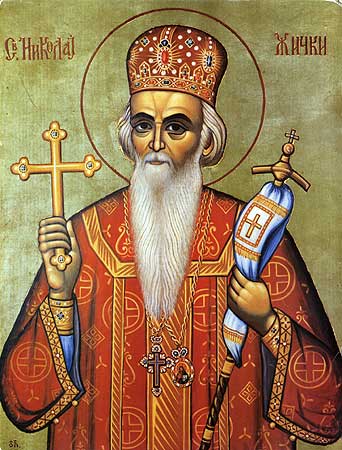 Saint Nicholas of Zhicha, “the Serbian Chrysostom,” was born in Lelich in western Serbia on January 4, 1881 (December 23, 1880 O.S.). His parents were Dragomir and Katherine Velimirovich, who lived on a farm where they raised a large family. His pious mother was a major influence on his spiritual development, teaching him by word and especially by example. As a small child, Nicholas often walked three miles to the Chelije Monastery with his mother to attend services there.
He was a man of compunctionate prayer, and possessesed the gift of tears which purify the soul (St John Climacus, LADDER, Step 7). He was a true pastor to his flock protecting them from spiritual wolves, and guiding them on the path to salvation. He has left behind many soul-profiting writings which proclaim the truth of Christ to modern man. In them he exhorts people to love God, and to live a life of virtue and holiness. May we also be found worthy of the Kingdom of Heaven through the prayers of St Nicholas, and by the grace of our Lord Jesus Christ, to Whom be glory forever. Amen. Saint Nicholas of Zhicha, “the Serbian Chrysostom,” was born in Lelich in western Serbia on January 4, 1881 (December 23, 1880 O.S.). His parents were Dragomir and Katherine Velimirovich, who lived on a farm where they raised a large family. His pious mother was a major influence on his spiritual development, teaching him by word and especially by example. As a small child, Nicholas often walked three miles to the Chelije Monastery with his mother to attend services there.
He was a man of compunctionate prayer, and possessesed the gift of tears which purify the soul (St John Climacus, LADDER, Step 7). He was a true pastor to his flock protecting them from spiritual wolves, and guiding them on the path to salvation. He has left behind many soul-profiting writings which proclaim the truth of Christ to modern man. In them he exhorts people to love God, and to live a life of virtue and holiness. May we also be found worthy of the Kingdom of Heaven through the prayers of St Nicholas, and by the grace of our Lord Jesus Christ, to Whom be glory forever. Amen.
The Holy Martyr Conon the Gardener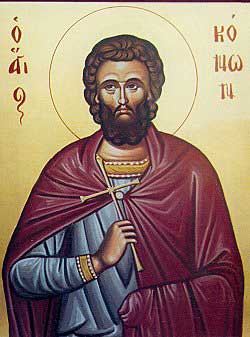 From Nazareth, he was mild and virtuous, and pleasing to God in all things. During the persecution under Decius, he was tortured for Christ, but he remained firm in the Faith, and sharply denounced the judges for their folly. With nails through his legs, this good and virtuous saint was bound behind the prince"s chariot and was dragged on and on, until he was utterly spent. Then he made his last prayer to God and gave his soul into His keeping, in 251. From Nazareth, he was mild and virtuous, and pleasing to God in all things. During the persecution under Decius, he was tortured for Christ, but he remained firm in the Faith, and sharply denounced the judges for their folly. With nails through his legs, this good and virtuous saint was bound behind the prince"s chariot and was dragged on and on, until he was utterly spent. Then he made his last prayer to God and gave his soul into His keeping, in 251.Our Holy Father Hesychius the Faster He was born near Bursa in the eighth century, but withdrew to a mountain called the hill of Maion, a place with an evil reputation for diabolical apparitions. He built himself a hut there, and a church dedicated to St Andrew, and also made himself a garden which he cultivated in order to live by his own toil. Miracles were worked through his prayers. He foretold that there would be a women"s monastery in that place after his death. A month before he died, he foretold the day and hour of his death, and at midnight on the day foretold, people saw his hut illumined with an unusual light, and, when they came to it, they found him dead. He was buried in the church of St Andrew, but later Theophylact, the bishop of Amasea, took him to the town of Amasea. He departed this life peacefully and went to the Kingdom of his God in 790. (In the Greek Synaxarion, he is commemorated on March 6th.) He was born near Bursa in the eighth century, but withdrew to a mountain called the hill of Maion, a place with an evil reputation for diabolical apparitions. He built himself a hut there, and a church dedicated to St Andrew, and also made himself a garden which he cultivated in order to live by his own toil. Miracles were worked through his prayers. He foretold that there would be a women"s monastery in that place after his death. A month before he died, he foretold the day and hour of his death, and at midnight on the day foretold, people saw his hut illumined with an unusual light, and, when they came to it, they found him dead. He was buried in the church of St Andrew, but later Theophylact, the bishop of Amasea, took him to the town of Amasea. He departed this life peacefully and went to the Kingdom of his God in 790. (In the Greek Synaxarion, he is commemorated on March 6th.)Our Holy Father Mark the Ascetic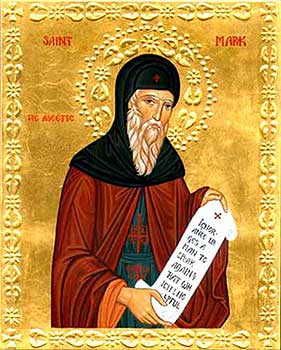 An ascetic and wonderworker, he was made a monk at the age of forty by his teacher, St John Chrysostom. Mark spent sixty more years in the Nitrian desert in fasting, prayer and the writing of instructive books. He knew the whole of the Holy Scriptures by heart. He was very merciful, and wept for the distress of any one of God"s creature. He was once weeping for the blind whelp of a hyena when the whelp received its sight. In gratitude, the mother hyena brought him a sheepskin, and the saint forbade the hyena in future to slaughter the sheep of poor people. He received communion at the hands of an angel. His homilies on the spiritual law, on repentance, on sobriety and so forth fall into the first rank of ecclesiastical literature; the great Patriarch Photius himself held them in high esteem. An ascetic and wonderworker, he was made a monk at the age of forty by his teacher, St John Chrysostom. Mark spent sixty more years in the Nitrian desert in fasting, prayer and the writing of instructive books. He knew the whole of the Holy Scriptures by heart. He was very merciful, and wept for the distress of any one of God"s creature. He was once weeping for the blind whelp of a hyena when the whelp received its sight. In gratitude, the mother hyena brought him a sheepskin, and the saint forbade the hyena in future to slaughter the sheep of poor people. He received communion at the hands of an angel. His homilies on the spiritual law, on repentance, on sobriety and so forth fall into the first rank of ecclesiastical literature; the great Patriarch Photius himself held them in high esteem.The Holy Martyr Conon of Isauria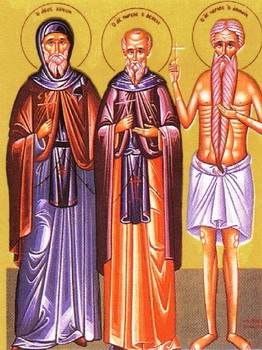 Conon was instructed in the Christian faith and baptised in the name of the Holy Trinity by the Archangel Michael himself, and he was accompanied by this archangel of God right up to his death. He was so enlightened and fortified by grace of the Holy Spirit, so that his heart was kept from all things earthly and clave to the spiritual and heavenly. When his parents forced him to marry, he, on the first evening, took a candle and put it inder a vessel, then asked his bride: "Which is better, light or darkness?" She answered: "Light", and he then began to speak to her of the Christian faith, and of the spiritual life as better and finer than the physical. He succeeded in bringing first her and then his parents to the Christian faith, and he and his wife lived as brother and sister. His wife and parents soon died, and he withdrew himself entirely from the world and gave himself to prayer, fasting and pondering on God. He performed great wonders, which brought many to Christianity. Among other wonders, evil spirits were forced to serve him. During a persecution he was arrested and tortured, and stabbed all over with knives. The sick anointed themselves with his blood and were healed. He lived for two further years in his own town, and went to the Lord. This wonderful saint lived and suffered in the second century. Conon was instructed in the Christian faith and baptised in the name of the Holy Trinity by the Archangel Michael himself, and he was accompanied by this archangel of God right up to his death. He was so enlightened and fortified by grace of the Holy Spirit, so that his heart was kept from all things earthly and clave to the spiritual and heavenly. When his parents forced him to marry, he, on the first evening, took a candle and put it inder a vessel, then asked his bride: "Which is better, light or darkness?" She answered: "Light", and he then began to speak to her of the Christian faith, and of the spiritual life as better and finer than the physical. He succeeded in bringing first her and then his parents to the Christian faith, and he and his wife lived as brother and sister. His wife and parents soon died, and he withdrew himself entirely from the world and gave himself to prayer, fasting and pondering on God. He performed great wonders, which brought many to Christianity. Among other wonders, evil spirits were forced to serve him. During a persecution he was arrested and tortured, and stabbed all over with knives. The sick anointed themselves with his blood and were healed. He lived for two further years in his own town, and went to the Lord. This wonderful saint lived and suffered in the second century.New Martyr John the BulgarianThe Martyr John the Bulgarian was a native of Bulgaria. In his early youth through spiritual immaturity he became enmeshed in the devil's snares, succumbing to the superstitions of the Turks and renouncing his faith in Christ. In a short while the hapless fellow realised the full gravity of his transgression, and he left his native region for Holy Mount Athos, and there in the Laura of Saint Athanasias, in full obedience to an elder, he besought forgiveness of God with bitter tears and prayers of repentance. The power of repentance in young John was so great and his desire to serve the True God so intense, that he left the Holy Mountain and went to Constantinople. There, in the church of Saint Sophia, which had been converted into a mosque, he began openly and fearlessly to confess Christianity. The saint was unmoved both by the false flattery and the fierce threats of the Hagarites. On 5 March 1784 the 19 year old preacher was beheaded.
Martyr Onisius of IsauriaThe Holy Martyr Onysios lived in Palestine. He was beheaded with the sword for confessing faith in Christ.
Venerable Mark the Faster of Egypt The Monk Mark asceticised during the V Century in the Nitreian wilderness (Lower Egypt). From the time of his youth the fondest pursuit for him was the reading of Holy Scripture. There is an account, that he knew the whole Bible by heart. It is known also, that the Monk Mark heard the preaching of Saint John Chrysostomos. Many a discourse written by Saint Mark has come down to us. The monk was noted for his gentleness, purity of soul and abstinence, for which he was called a "fast-keeper". The Monk Mark asceticised during the V Century in the Nitreian wilderness (Lower Egypt). From the time of his youth the fondest pursuit for him was the reading of Holy Scripture. There is an account, that he knew the whole Bible by heart. It is known also, that the Monk Mark heard the preaching of Saint John Chrysostomos. Many a discourse written by Saint Mark has come down to us. The monk was noted for his gentleness, purity of soul and abstinence, for which he was called a "fast-keeper".Virgin-martyr Irais (Rhais) of Antinoe in EgyptMartyr Archelaus and 152 Martyrs in Egypt
Martyr Eulogius of Palestine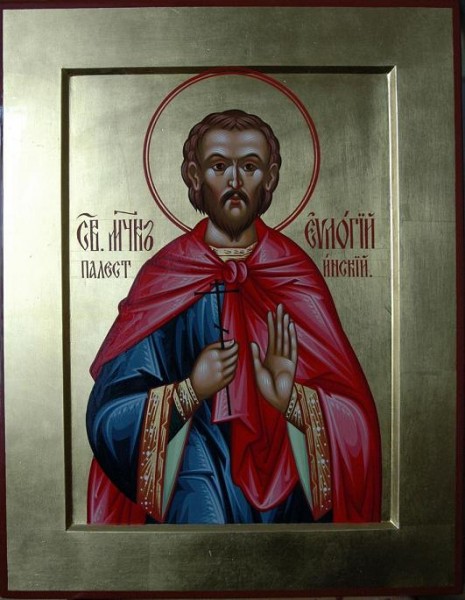 The Holy Martyr Eulogios was a native of Palestine. After the death of his pagan parents he gave away all his inheritance to the poor, and he himself became a wanderer and went about through Palestine, converting pagans to Christianity. During the time of a persecution he was arrested, subjected to terrible tortures and beheaded. The Holy Martyr Eulogios was a native of Palestine. After the death of his pagan parents he gave away all his inheritance to the poor, and he himself became a wanderer and went about through Palestine, converting pagans to Christianity. During the time of a persecution he was arrested, subjected to terrible tortures and beheaded.Martyr Eulampius of PalestineThe Holy Martyr Eulampios lived in Palestine. He was beheaded for his faith in Christ.
New Hieromartyr Parthenius, Bishop of Didymoteichon in Thrace (1805)Monk-martyr Adrian, abbot of Poshekhonye and his fellow-ascetic St. Leonidas The Monk Adrian of Poshekhonsk was born at Rostov the Great at the end of the XVI Century, of pious parents named Grigorii and Irina. The Monk Adrian accepted monastic tonsure at the monastery of Saint Kornilii of Komel'sk (Comm. 19 May).
Among the brethren gathered around the Monk Kornilii were no few capable builders and iconographers, such that the monastery churches were constructed and adorned by the monks themselves. In the final years of the Monk Kornilii's life, Kazan Tatars made a plundering invasion of the locale of the monastery, and he led off all the brethren to the River Ukhtoma. But the Tatars did not touch the monastery, being frightened off by the sight of the many soldiers defending it, and they soon withdrew from the Vologda district. The Monk Kornilii returned to the monastery with the brethren and reposed there on 19 May 1537. The Monk Adrian of Poshekhonsk was born at Rostov the Great at the end of the XVI Century, of pious parents named Grigorii and Irina. The Monk Adrian accepted monastic tonsure at the monastery of Saint Kornilii of Komel'sk (Comm. 19 May).
Among the brethren gathered around the Monk Kornilii were no few capable builders and iconographers, such that the monastery churches were constructed and adorned by the monks themselves. In the final years of the Monk Kornilii's life, Kazan Tatars made a plundering invasion of the locale of the monastery, and he led off all the brethren to the River Ukhtoma. But the Tatars did not touch the monastery, being frightened off by the sight of the many soldiers defending it, and they soon withdrew from the Vologda district. The Monk Kornilii returned to the monastery with the brethren and reposed there on 19 May 1537. |